Doing Science!
In previous journals I explained how we set up sites. We are studying 3 plants and we have 9 locations (3 cold, 3 medium, and 3 warm) for each with a total of 27. After we find the locations we tag 15 sets of flowers with different colored string to mark treatments.
Orange - Additional pollen added by hand (supplemented)
Red- Nothing is done (control)
Bagged with blue string - no pollination
Bagged with pink string (only 5 at each site) - bagged and hand pollinated. This is done to make sure the bags are not killing the flowers because these flowers are still receiving pollination.
 Here is one plot, contaning the 3 tagged plants, of the 15 plots at a site
Here is one plot, contaning the 3 tagged plants, of the 15 plots at a site
After we tag the flowers we find the abiotic (non-living variables) such as wind speed, aspect, and temp.
Next we find the vegetation coverage. This is done by laying the measuring tape from one side of the plot to the other (transact). We then observe every half meter and determine what plants are present and the percentage.
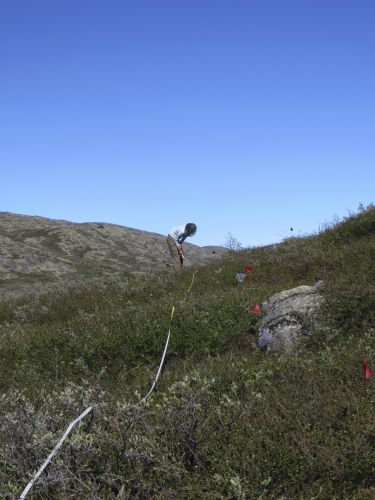 We are finding the vegetations coverage. This is done by laying a measuring tape out and observing which flowers are present
We are finding the vegetations coverage. This is done by laying a measuring tape out and observing which flowers are present
Before we start the "Science" part we place an i-button which records temperature for the next couple of months.
 I-buttons which measure temperature. We place one of these at each site in order to track the temperature in a area. This is important since part of the project is looking at different temperatures
I-buttons which measure temperature. We place one of these at each site in order to track the temperature in a area. This is important since part of the project is looking at different temperatures
Now we are ready to start "treating" the flowers. There are 5 processes we go through before we move to another site.
Supplement the pollen (collect pollen and place on plants with the orange string)
Count the number of pollinators
Measure flower density of the area we are observing for pollinators
Paint glue on a couple of flowers
Measure plant height and how big the flower is (if the flower has bloomed)
 This site is completely prepared. Notice all of the bagged plants.
This site is completely prepared. Notice all of the bagged plants.
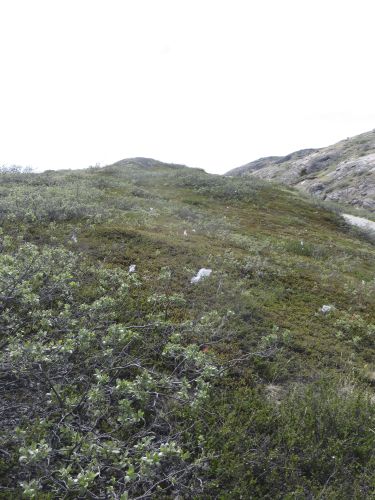 Everything has been carried out at this site. We will nto come back until it is time to supplement again
Everything has been carried out at this site. We will nto come back until it is time to supplement again
Supplementing the pollen is different for each type of flower. I have not supplemented any Nivi plants yet because they bloom later. Because of this I have not supplemented them and I don't have any pictures. I have to say hand pollinating the blueberries is the hardest. First we have to collect the pollen which means that each person collects around 180 blooms each from a different plant.
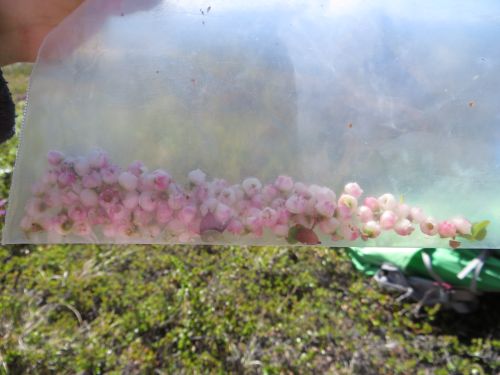 We collect about 180 vacc/blueberry blooms per person to use for supplementing pollen.
We collect about 180 vacc/blueberry blooms per person to use for supplementing pollen.
You can see that the bloom is very small so handling them is the first issue. After we collect the bloom we pull the petals off the picked blooms and place the inside of that flower into the tagged plant. This transfers pollen from the picked bloom into the tagged flower. We do this three times per bloom and we use each picked bloom twice. Sometimes the tagged flower can have up to 15 blooms so this can be time consuming.
 A vacc/blueberry patch. They are so pretty when the whole patch is blooming. Not all blooms will actually turn into blueberries
A vacc/blueberry patch. They are so pretty when the whole patch is blooming. Not all blooms will actually turn into blueberries
 Supplementing a Vacc/blueberry flower by placing one bloom (with the petals torn off) inside of the tagged flower
Supplementing a Vacc/blueberry flower by placing one bloom (with the petals torn off) inside of the tagged flower
Supplementing the willow is much easier. What is unique about the willow is that there is actually a male and female plant. This means that we have to pick the male catkins which contain the pollen and make sure we spread the pollen on the female catkins which contain the seeds. The pollen comes off much easier than the blueberry so we only have to use 2 male catkins per 1 female catkin.
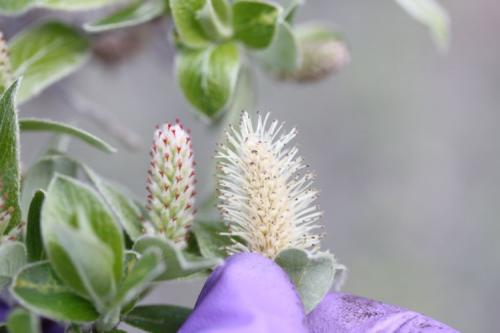 A male and female catkin off of a Salix/willow bush. The female is on the left and is more smoothwiths red tips. The male is on the right and is really bushy with yellow (pollen) tips.
A male and female catkin off of a Salix/willow bush. The female is on the left and is more smoothwiths red tips. The male is on the right and is really bushy with yellow (pollen) tips.
 I am supplementing a Salix/willow bush by brushing the male catkin on the female catkin
I am supplementing a Salix/willow bush by brushing the male catkin on the female catkin
The next step is observing pollinators. First, we mark off a half meter by half meter section next to a set of the tagged flowers. We do this using rope. We then sit there for 4 minutes and use a voice recorder to record anything we see land on a flower or petal. The typical pollinators we see fit into three categories.
Flies - hover fly, house fly Mosquitoes - they do have a purpose Bees - there are 2 species of bumble bees
During this observation we also count the number of blooms/catkins and record that data (flower density). We do this for each of the 15 sets of tagged plants per plot.
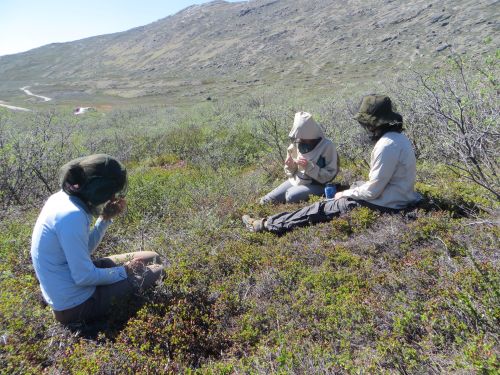 We are learning to observe pollinators. We sit at a group of flowers for 4 minutes and record whatever we see in a voice recorder
We are learning to observe pollinators. We sit at a group of flowers for 4 minutes and record whatever we see in a voice recorder
Next, we choose some flowers/catkins and paint glue on the bloom. This is another way to catch pollinators so that we can determine what is pollinating flowers.
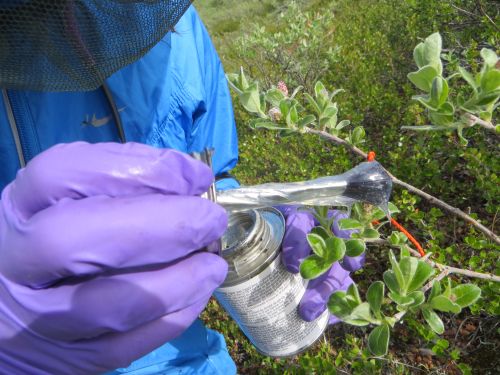 Placing glue on flowers/catkins in order to catch pollinators
Placing glue on flowers/catkins in order to catch pollinators
Finally, we choose the tallest plant in the area we tagged the flowers and measure the height. We will eventually measure the length of the flower once they bloom.
Overall this take around 2 hours per site with 2 people. I am usually very tired and mentally taxed by the end of the day, so it helps when we have good food (this is every night)!
 Mac and Cheese with peas with of course hot sauce.
Mac and Cheese with peas with of course hot sauce.
Strange fact of the Day: It is really easy to convert Fahrenheit to Celsius (what the US uses). Double the Fahrenheit temperature and then add 30. For example yesterday was 13 degrees Fahrenheit near the ice sheet. If you double the 13 it equals 26 and then add 30. This makes the temperature 56 degrees Celsius at the ice sheet.


Comments